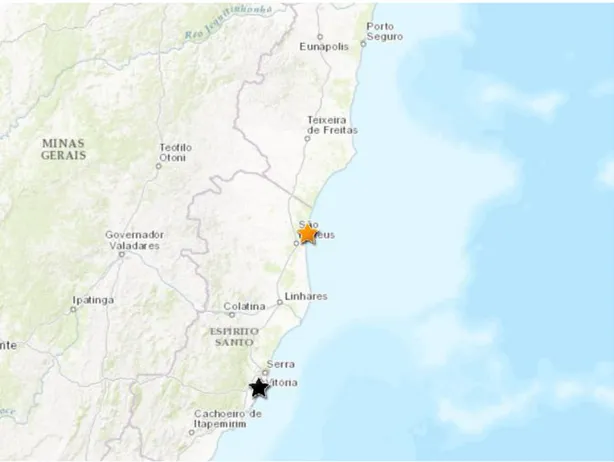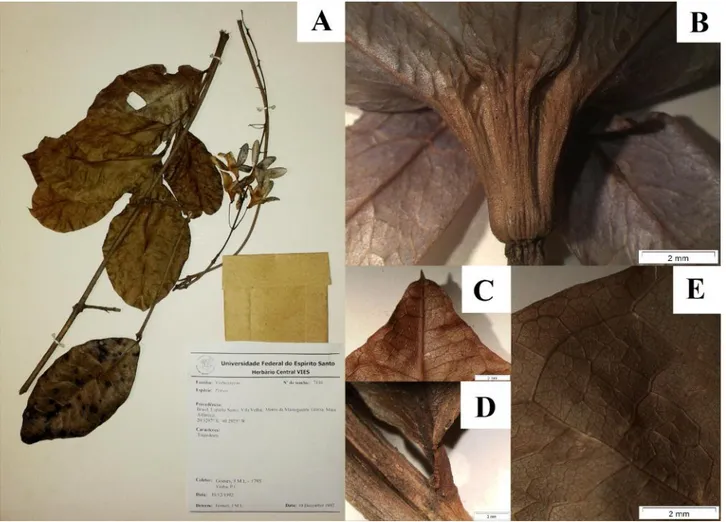NEW RECORDS OF VERBENACEAE FOR ESPÍRITO SANTO, BRAZIL NOVOS REGISTROS DE VERBENACEAE PARA O ESPÍRITO SANTO, BRASIL Andressa Cabral1*, Pedro Henrique Cardoso1, Pâmela Tavares-Silva2& Fernanda
Santos-Silva1
*Autora para correspondência: acabral@outlook.com.br 1
Departamento de Botânica, Instituto de Ciências Biológicas, Campus Universitário, s/n, São Pedro, Universidade Federal de Juiz de Fora, CEP 36036-900, Juiz de Fora, Minas Gerais, Brasil. 2
Instituto de Biociências, Universidade de São Paulo, Rua do Matão, 277 - CEP 05508-090, Cidade Universitária, São Paulo, Brasil.
ABSTRACT
Verbenaceae currently presents a pantropical distribution, with center of diversity in the neotropical region. The Brazil stands out as an important center of diversity for the family, but few studies with a taxonomic focus were performed for the Brazilian representatives. In the present study, the occurrence of Lantana salzmannii and the genus Petrea, with the species Petrea volubilis, is recorded for the first time in the Espírito Santo flora, extending the limit of distribution of these taxa in the Atlantic Forest domain. Distribution and habitat descriptions, images and comments are provided for these taxa.
Keywords: Atlantic Forest. Lantana. Petrea.
RESUMO
Verbenaceae apresenta atualmente uma distribuição pantropical, com centro de diversidade na região neotropical. O Brasil se destaca como um importante centro de diversidade para a família, mas poucos estudos com foco taxonômico foram realizados para os representantes brasileiros. No presente estudo é registrada pela primeira vez a ocorrência de Lantana salzmannii e do gênero
146
Petrea, com a espécie Petrea volubilis, para a flora do Espírito Santo, estendendo o limite de distribuição destes táxons no domínio da Floresta Atlântica. São fornecidas descrições, imagens e comentários da distribuição e do habitat para estes táxons.
Palavras-chave: Floresta Atlântica. Lantana. Petrea.
Verbenaceae currently comprises 34 genera and about 1.200 species, and presents a pantropical distribution, with center of diversity in the neotropical region (ATKINS, 2004). The Brazil stands out as an important center of diversity for the family, where 289 species are known, distributed in 16 genera, with greater diversity in Cerrado and Campos Rupestres (BFG, 2015).
Few studies with a taxonomic focus were performed for the Brazilian family representatives, mentioning the extensive work of Schauer (SCHAUER, 1847), and some state and regional floras (ATKINS, 2004, 2005)(HARLEY & SIMMONS, 1986)(LUIZI-PONZO, 1997)(SALIMENA, 2000)( SALIMENA-PIRES & GIULIETTI, 1998)(SALIMENA & SILVA, 2009)(SALIMENA et al., 2016)(SANTOS et al., 2009). Being also emphasized the absence of taxonomic studies of Verbenaceae focused in Espírito Santo.
In the present study, the records of Lantana salzmannii Schauer and the genus Petrea L. with the species Petrea volubilis L. were added to the flora of Espírito Santo. Consequently, was extended the limit of distribution of these taxa (Figure 1). The specimens examined were deposited in the collection of Herbarium Leopoldo Krieger of the Universidade Federal de Juiz de Fora (CESJ) (THIERS, 2017). For the identification of species, literature (ATKINS, 2004, 2005)(SALIMENA-PIRES & GIULIETTI, 1998)(SALIMENA et al., 2016)(SILVA, 1999) and the specialist, F.R.G. Salimena (CESJ), were consulted. In the morphological descriptions, we prioritized show characters of easy visualization and important to delimit the species. The morphological descriptions followed the terminologies proposed by Gonçalves & Lorenzi (2007), Harris & Harris (2003) and Radford (1986).
Figure 1. Locations of occurrence of two new records in Espírito Santo. Collection point of Lantana salzmannii (in yellow) and Petrea volubilis (in black).
Lantana L. encompasses around 150 species distributed throughout the Americas from Argentina to southern United States, with few representatives in Africa and Asia (ATKINS, 2004)(SILVA, 1999). In Brazil, it occurs in all states and phytogeographic domains, with 20 species, of which ten are endemic (BFG, 2015). In Espírito Santo are found five species of the genus (BFG, 2015). The presence of Lantana salzmannii was only mentioned in the Atlantic Forest domain for the states of Bahia and Sergipe (BFG, 2015)(SILVA, 1999). The species is heliophilous, found in small populations of ombrophilous forests, dunes and restingas (BFG, 2015)(SILVA, 1999). Thus, its distribution is expanded to the Espírito Santo, where it occurs in areas of shrub restingas.
Lantana salzmannii Schauer, Prodr. 11: 602. 1847: Shrubs or subshrubs ca. 1 m tall, tetragonal branches, unarmed, hirsute. Leaves opposite, petiole 1.7–3.7 mm long, blade 9.6–33.1 x
148
2.9–15.8 mm, elliptic to obovate, apex acute to obtuse, crenate margins, base decurrent, adaxial surface strigose, lustrous, abaxial surface densely-glandular with tectorial trichomes along the veins. Inflorescence 11-13 mm length, unequal bracts, basal bracts widely-ovate, internal bracts elliptic-oblong; calix campanulate, green, pubescent; corolla 9.8–10.9 mm long,zygomorphic, lilac or pink, externally pubescent, with glandular trichomes; stamens 4, inserted in the middle of the corolla tube. Fruit not seen.
Material examined: ESPÍRITO SANTO. Conceição da Barra. Restinga. Formação de Ericaceae: 24.III.1999, fl., Pereira et al. 3017 (CESJ, VIES). Figure 2.
Figure 2. Lantana salzmannii. A. Habit. B. Inflorescence. C. Apical region of the leaf, adaxial surface. D. Apical region of the leaf, abaxial surface. E. Detail of indumentum in abaxial leaf surface.
Petrea has about 11 species distributed in the Americas, from Argentina to the South of the United States, occurring in Mexico, Brazil, Paraguay and Bolivia (ATKINS, 2004). Brazil
constitutes an important center of diversity of the genus, with nine species, of which three are endemic (BFG, 2015). Its representatives are found in Goiás (SALIMENA et al., 2016), Acre, Amazonas, Pará, Rondônia, Roraima, Bahia, Distrito Federal, Mato Grosso, Minas Gerais, São Paulo, Paraná, Santa Catarina, and with possible occurrences for Rio de Janeiro (BFG, 2015). In the present study, it was recorded for the first time the occurrence of this genus in Espírito Santo, with a specimen of Petrea volubilis. For Brazil, occurrence of this species was recorded for Amazonas, Bahia, Minas Gerais, Pará, Paraná, São Paulo, Santa Catarina, Distrito Federal and Goiás until then (BFG, 2015)(SALIMENA et al., 2016), thus increasing now its distribution in the Brazilian territory.
Petrea volubilis L., Sp. Pl. 2: 626. 1753: Lianas, tetragonal branches, glabrescent to pubescent. Leaves opposite; petiole 3–7 mm long, blade 69–103 × 31.2–60 mm, chartaceous, oblong-elliptic, apex acute or emarginate, entire margins, base cuneate, adaxial and abaxial surface glabrous. Inflorescences ca. 23 cm length; bracts ca. 5 mm length, lanceolate, calyx ca. 6 cm long, petaloid, tubular, blue or lilac, pubescent, glandular trichomes concentrated at the base; corolla 13– 15 mm long, zygomorphic, lilac, externally pubescent-glandular; stamens 4, inserted in the upper portion of the tube, nectariferous basal disc; ovary 1-carpelar, 2-locular, 1-ovulate-locular. Fruit not seen.
Material examined: ESPÍRITO SANTO. Vila Velha. Morro da Manteigueira. Glória: 10.XII.1992, fl., Gomes et al. 1795 (VIES). Figure 3.
150
Figure 3.Petrea volubilis. A. Habit. B. Detail of the calyx. C. Apical region of the leaf. D. Petiole and leaf basal region. E. Margin and leaf venation.
These results confirm the importance of the botanical collections for the study of the biodiversity at the regional level. Herbarium collections act as true database about the flora and they are the basis of knowledge about its composition, distribution and conservation. These data contribute in a decisive way to creation of protection areas for the conservation of species under different degrees of threat.
REFERENCES
ATKINS, S. Verbenaceae. In: K. KUBTZKI; J.W. KADAREIT. (Eds.). The Families and Genera of Flowering Plants. Berlin, Springer-Verlag, 2004. p.449-468.
ATKINS, S. The genus Stachytarpheta (Verbenaceae) in Brazil. Kew Bulletin, England, v.60, n.2, p.161-272. 2005.
BFG (The Brazil Flora Group). Growing knowledge: an overview of Seed Plant diversity in Brazil. Rodriguésia, Rio de Janeiro, v.66, n.4, p.1085-1113. 2015.
GONÇALVES, E.G.; LORENZI, H. Morfologia vegetal: organografia e dicionário ilustrado de morfologia das plantas vasculares. Nova Odessa: Instituto Plantarum. 2007. 416p.
HARLEY, R.M.; SIMMONS, N.A. Florula of Mucugê, Chapada Diamantina, Bahia, Brasil. London: Royal Botanical Gardens. 1986.
HARRIS, J.G.; HARRIS, M.W. Plant identification terminology: an illustrated glossary. 2ed. Spring Lake: Spring Lake Publ. 2003. 216p.
LUIZI-PONZO, A.P. Verbenaceae. In: MARQUES, M.C.M.; VAZ, A.S.F.; MARQUETE, R. (Eds.). Flórula da APA Cairuçu, Parati, Rio de Janeiro. Instituto de Pesquisas Jardim Botânico do Rio de Janeiro, Série Estudos e Contribuições, v.14, 1997. p.558-564.
RADFORD, A. E. Fundamentals of plant systematics. New York: Harper & Row. 1986. 498p. SALIMENA, F.R.G. Verbenaceae. In: MELO, M.M.R.F.; BARROS, F.; WANDERLEY, M.G.L.; KIRIZAWA, M.; JUNG-MENDAÇOLLI, S.L.; CHIEA, S.A.C. (Eds.). Flora fanerogâmica da Ilha do Cardoso, São Paulo. São Paulo, Instituto de Botânica, v.7, 2000. p.7-26.
SALIMENA-PIRES, F.R.; GIULIETTI, A.M. Flora da Serra do Cipó, Minas Gerais: Verbenaceae. Boletim de Botânica da Universidade de São Paulo, São Paulo, v.17, p.155-186. 1998.
SALIMENA, F.R.G.; SILVA, T.R.S. Flora de Grão- Mogol, Minas Gerais: Verbenaceae. Boletim de Botânica da Universidade de São Paulo, São Paulo, v.27, p.119-126. 2009.
SALIMENA, F.R.G.; FERREIRA, S.C.; CARDOSO, P.H.; VALÉRIO, V.I.R. Verbenaceae. In: RIZZO, J.A. (Ed.). Flora dos Estados de Goiás e Tocantins. Universidade Federal de Goiás, Goiânia, v.47, 2016. p.1-157.
SANTOS, J.S.; MELO, J.I.M.; ABREU, M.C.; SALES, M.F. Verbenaceae sensu stricto na região de Xingó: Alagoas e Sergipe, Brasil. Rodriguésia, Rio de Janeiro, v.60, p.985-998. 2009. SCHAUER, J.C. Verbenaceae. In: A. P. DE CANDOLLE (Ed). Prodromus Systematis Naturalis Regni Vegetabilis. Paris, Victor Masson, v.11, 1847. p.522-700.
SILVA, T.R.S. Redelimitação e revisão taxonômica do gênero Lantana L. (Verbenaceae) no Brasil. Tese de Doutorado. Universidade de São Paulo, São Paulo. 1999.
THIERS, B. [continuously updated]. Index Herbariorum: A global directory of public herbaria and associated staff.New York BotanicalGarden's Virtual Herbarium. Disponível em <http://sweetgum.nybg.org/ih/>. Acesso em 30 janeiro 2017.


